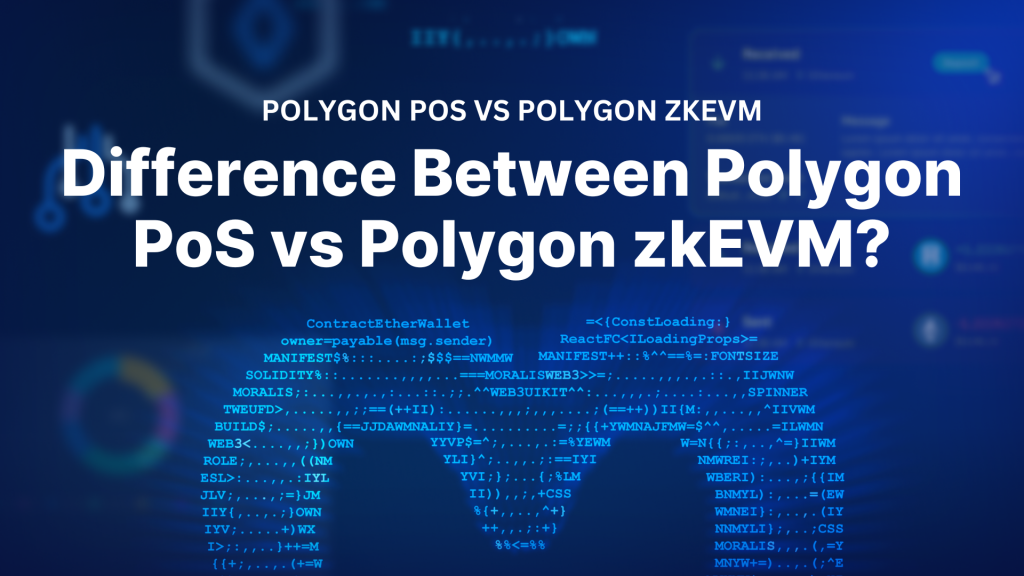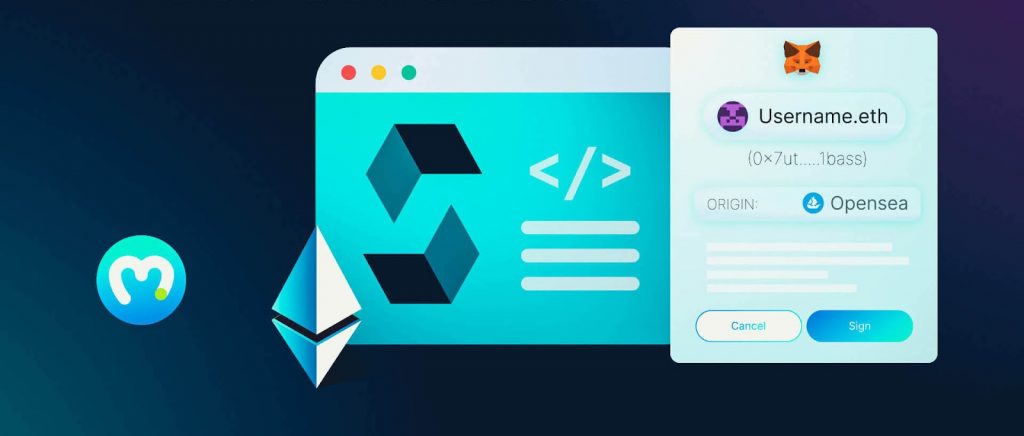[ad_1]

The scalability issues of the Ethereum network are no secret, and they have persisted over the past few years. This, in combination with the growing demand for Ethereum-based decentralized applications (dapps), clearly highlights the need for scalable and cost-efficient solutions. Polygon – a prominent Ethereum scaling solution – provides two distinct approaches to tackle the associated challenges: Polygon PoS and Polygon zkEVM. But what are these two solutions? And what sets them apart? For the answers to these two questions, join us in this article as we compare and explore the differences between Polygon PoS vs Polygon zkEVM!
Overview
In today’s article, we’ll kick things off by exploring the intricacies of both Polygon PoS and Polygon zkEVM. From there, we’ll compare Polygon PoS vs Polygon zkEVM to highlight the main similarities and differences between these two scaling solutions. In doing so, we’ll examine their architectures, consensus mechanisms, data availability, etc. We’ll also explore some prominent use cases for Polygon PoS and Polygon zkEVM, respectively. Lastly, to top things off, we’ll introduce you to Moralis’ Web3 API suite – the ultimate tool for building Polygon-compatible dapps!
In Moralis’ suite of industry-leading APIs, you’ll find tools such as our free NFT API, the best API for crypto prices, and many others. With these APIs, you can effortlessly leverage the scalability capabilities of the Polygon ecosystem and build dapps faster and smarter.

If this is your ambition, then sign up with Moralis immediately. You can create an account for free, and you’ll gain immediate access to all our industry-leading tools in a heartbeat!
Nevertheless, without further delay, let’s kick things off by exploring the ins and outs of Polygon PoS!
What is Polygon PoS?
Polygon proof-of-stake (PoS) initially launched as Matic Network in 2017, and it’s a layer-2 (L2) scaling solution for the Ethereum blockchain. Furthermore, this network leverages a PoS consensus mechanism and a “Plasma” framework to create a sidechain running parallel to the Ethereum mainnet. In doing so, Polygon PoS can address the scalability issues of the Ethereum network, lowering transaction fees and increasing throughput significantly!

Polygon PoS is one of the most well-established protocols within the Web3 space. The network hosts thousands and thousands of decentralized applications (dapps), processes an average of more than three million daily transactions, and industry leaders are building on the chain.
So, what are some of the key benefits of building on Polygon PoS?
- Low Cost: Polygon PoS is able to offer much lower transaction fees compared to the Ethereum mainnet, with the average cost per transaction being approximately $0.015.
- Community Support: The network features a highly active and engaged community of developers. What’s more, Polygon PoS offers 24/7 development support.
- EVM Compatible: Polygon PoS is EVM-compatible, meaning you can effortlessly deploy dapps from Ethereum to the network and leverage developer tools you’re familiar with when building projects, including MetaMask, Truffle, etc.
- Well-Established: Polygon PoS is trusted by some of the most significant brands in Web2 and Web3. Moreover, with an already-established user base, onboarding new users to your projects is easy.
What is Polygon zkEVM?
Polygon zkEVM is – much like Polygon PoS – also a decentralized Ethereum L2 scaling solution. This L2 scaling solution leverages cryptographic zero-knowledge (zk) proofs to offer validity and fast finality to off-chain transaction computations – a method also known as zk-rollup!

Zk-rollups can execute smart contracts transparently by publishing zero-knowledge validity proofs, all while maintaining opcode compatibility with EVM. As a result, Polygon zkEVM is fully equivalent to EVM, meaning that the vast majority of existing Ethereum tools, smart contracts, and wallets work seamlessly with the network.
Here are some of the main benefits of Polygon zkEVM:
- Low Cost: Polygon zkEVM leverages zero-knowledge proofs to minimize transaction costs. This results in lower total usage costs for the end users, providing a more compelling user experience.
- High Performance: Polygon zkEVM features fast network finality through frequent validity proofs. Moreover, with high performance, you can create many different types of dapps for a variety of use cases.
- EVM Equivalence: With full EVM equivalence, you can use any EVM smart contracts, wallets, and development tools directly on Polygon zkEVM. As a result, most existing Ethereum dapps work seamlessly on the network.
- Security: Experience the security of Ethereum in addition to the scalability capabilities of an L2 solution when working with Polygon zkEVM.
Polygon PoS vs Polygon zkEVM
Now, with an overview of both Polygon PoS and Polygon zkEVM, let’s explore some key differences between these two L2 solutions. In doing so, we’ll compare their respective consensus mechanisms, architectures, security, data availability, and more.
For a quick overview, here’s a table summarizing the key similarities and differences between Polygon PoS vs Polygon zkEVM:
| Polygon PoS vs Polygon zkEVM | ||
| Polygon PoS | Polygon zkEVM | |
| Architecture | Polygon PoS leverages a PoS consensus mechanism and Plasma framework to create a sidechain. | Polygon zkEVM features a zk-rollup architecture that leverages zero-knowledge proofs to provide an L2 solution on top of Ethereum. |
| Consensus Mechanism | PoS | Consensus Contract |
| Smart Contract Compatibility | EVM Compatibility | EVM Equivalence |
| Security | Polygon PoS features an independent set of validators securing the sidechain. | Polygon zkEVM is secured by Ethereum as validity proofs are stored on-chain. |
| Data Availability | Data is available directly on the sidechain. | There are two options for data availability: Validium & Volition. |
Nevertheless, without further ado, let’s start our Polygon PoS vs Polygon zkEVM comparison by closely examining their respective architecture!
Architecture
Polygon PoS uses a Plasma framework and functions as a PoS sidechain running parallel to the Ethereum blockchain. Consequently, it provides a separate network that increases bandwidth for transactions, lowering fees and increasing throughput compared to Ethereum.

Polygon zkEVM leverages a zk-rollup architecture that uses zero-knowledge proofs to provide an L2 solution operating on top of the Ethereum network. The zk-rollup technology allows complex computations to occur off-chain while cryptographic proofs are generated and submitted on-chain.
Consensus Mechanism
Polygon PoS uses a PoS consensus mechanism and relies on a set of validators to confirm and validate transactions on the sidechain. Also, the network features around 100 validators who need to stake MATIC tokens to become eligible to participate. What’s more, block producers are selected based on the size of their staked amount.
Polygon zkEVM, on the other hand, leverages a consensus contract supporting the permissionless participation of multiple coordinators – including sequencers and aggregators – to produce and validate off-chain transactions in batches that are later submitted on-chain. Moreover, staking or special roles are not required to participate in this system.
Smart Contract Compatibility
Polygon PoS offers EVM compatibility, meaning you can deploy and execute Ethereum smart contracts on the sidechain. However, it’s worth noting that EVM compatibility also implies that there may be some slight differences in the execution environment between the sidechain and the Ethereum mainnet. Consequently, on occasions when dealing with low-level code or complex dapps, you might need to make certain alterations to your smart contracts when porting them from Ethereum to Polygon PoS.

On the other hand, Polygon zkEVM focuses on achieving EVM equivalence, which implies an even higher level of compatibility with the Ethereum network. As a result, Polygon zkEVM allows you to deploy and run existing Ethereum smart contracts on the network seamlessly without any modifications.
All in all, the critical difference is that Polygon zkEVM aims to replicate the Ethereum execution environment fully, while Polygon PoS focuses on offering compatibility with Ethereum smart contracts. As such, Polygon zkEVM allows you to maintain the same workflow on the L2 solution as you would on the Ethereum mainnet.
Security
Polygon PoS highly depends on its validators to secure the sidechain, and it operates independently from the Ethereum mainnet. On the other hand, Polygon zkEVM is secured by Ethereum as validity proofs are published on-chain, ensuring that all off-chain computations are correct and secure.
Data Availability
On Polygon PoS, the state and all transaction data are available directly on the sidechain. This allows for fast data retrieval and cross-referencing; however, it comes at a cost of extra storage.
Polygon zkEVM features a hybrid solution offering two options for data availability:
- Validium: Data is stored off-chain, where only proofs are kept on the Ethereum mainnet. This method offers improved storage efficiency.
- Volition: This is a hybrid option where crucial data can optionally be stored on-chain while the rest remains off-chain. This provides a balance between storage efficiency and fast access.
Polygon PoS vs Polygon zkEVM Use Cases
Both Polygon PoS and Polygon zkEVM have their own set of benefits and advantages. And since they have different capabilities, they are somewhat suited for different use cases. So, let’s take this section to look at some prominent use cases for Polygon PoS and Polygon zkEVM, respectively!

Polygon PoS features high throughput and extremely low fees. Consequently, this makes Polygon PoS the perfect environment for dapps required to handle high transaction volumes. Some examples include Web3 games, social media dapps, trading platforms, and so on.
Polygon zkEVM features high security, which the L2 solution leverages from the Ethereum mainnet. This makes this network ideal for use cases like yield farming, high-value DeFi applications, etc., where security is prioritized over low transaction fees.
With that said, despite some slight differences between them, both Polygon PoS and Polygon zkEVM still offer low fees and high security. Consequently, nothing stops you from building high transaction volume dapps on Polygon zkEVM and secure platforms on Polygon PoS.
So, how do you build projects for the Polygon ecosystem?
If you want the answer to this query, join us in the next section as we introduce you to Moralis’ Web3 APIs – the ultimate tools for building Polygon dapps!
Build Seamlessly on Polygon with Moralis
Moralis is an industry-leading Web3 API provider, and our enterprise-grade interfaces make Web3 development as seamless as Web2. Consequently, when working with Moralis, you can effortlessly build on Polygon both faster and smarter!

In our suite of premier APIs, you’ll find multiple interfaces for various use cases. Furthermore, all of them support all major blockchain networks, including Polygon, Ethereum, BNB Smart Chain, Arbitrum, etc. Hence, it doesn’t matter if you’re looking to build an NFT marketplace or a Web3 wallet; we’ve got you covered!
To give you a few examples, here are some of our most prominent APIs:
- NFT API: Moralis’ NFT API is the industry’s premier interface for NFT data. The interface supports more than three million NFT collections and tokens across all major EVM chains, including Polygon. With single lines of code, you can get everything from real-time NFT transactions to enriched metadata.
- Wallet API: The Wallet API is the ultimate tool if you’re looking to build a Web3 wallet or integrate wallet functionality into your dapps. Also, this tool supports 500+ million wallets and boasts an array of features, unparalleled scalability, and high flexibility.
- Streams API: Moralis’ Streams API is the ultimate tool for automatically getting notified about real-time Web3 events. With this premier interface, you can effortlessly set up streams to get real-time, customizable updates sent immediately to your project’s backend via Web3 webhooks whenever something important occurs on-chain.
However, the APIs above are only a few examples of prominent Moralis interfaces. If you want to explore them all, check out our Web3 API page!
Also, did you know you can access all of our APIs for free? Simply sign up with Moralis, and you’ll be able to leverage the full power of blockchain technology in a heartbeat!
Summary: Polygon PoS vs Polygon zkEVM
In today’s article, we compared Polygon PoS vs Polygon zkEVM to highlight the similarities and differences between the two. In doing so, we examined their architectures, consensus mechanisms, data availability, etc. You’ll find a brief summary of the comparison in the table below:
| Polygon PoS vs Polygon zkEVM | ||
| Polygon PoS | Polygon zkEVM | |
| Architecture | Polygon PoS leverages a PoS consensus mechanism and Plasma framework to create a sidechain. | Polygon zkEVM features a ZK-rollup architecture that leverages zero-knowledge proofs to provide an L2 solution on top of Ethereum. |
| Consensus Mechanism | PoS | Consensus Contract |
| Smart Contract Compatibility | EVM Compatibility | EVM Equivalence |
| Security | Polygon PoS features an independent set of validators securing the sidechain. | Polygon zkEVM is secured by Ethereum as validity proofs are stored on-chain. |
| Data Availability | Data is available directly on the sidechain. | There are two options for data availability: Validium & Volition. |
If you liked this Polygon PoS vs Polygon zkEVM tutorial, consider reading more content here on Moralis. For instance, check out our crypto wallet history API guide, learn how to build a real-time wallet tracker, or explore the top block explorer API! Also, if you want to build Polygon projects yourself, don’t forget to sign up with Moralis. You can register entirely for free, and you’ll gain immediate access to all our industry-leading APIs!
[ad_2]
Read More: moralis.io








 Bitcoin
Bitcoin  Ethereum
Ethereum  Tether
Tether  XRP
XRP  Solana
Solana  USDC
USDC  TRON
TRON  Dogecoin
Dogecoin  Lido Staked Ether
Lido Staked Ether  Cardano
Cardano  Wrapped Bitcoin
Wrapped Bitcoin  Hyperliquid
Hyperliquid  Wrapped stETH
Wrapped stETH  Sui
Sui  Bitcoin Cash
Bitcoin Cash  Chainlink
Chainlink  LEO Token
LEO Token  Stellar
Stellar  Avalanche
Avalanche  Toncoin
Toncoin  WhiteBIT Coin
WhiteBIT Coin  USDS
USDS  Shiba Inu
Shiba Inu  WETH
WETH  Wrapped eETH
Wrapped eETH  Litecoin
Litecoin  Binance Bridged USDT (BNB Smart Chain)
Binance Bridged USDT (BNB Smart Chain)  Hedera
Hedera  Monero
Monero  Ethena USDe
Ethena USDe  Polkadot
Polkadot  Bitget Token
Bitget Token  Coinbase Wrapped BTC
Coinbase Wrapped BTC  Uniswap
Uniswap  Pepe
Pepe  Pi Network
Pi Network  Aave
Aave  Dai
Dai  Bittensor
Bittensor  Ethena Staked USDe
Ethena Staked USDe  BlackRock USD Institutional Digital Liquidity Fund
BlackRock USD Institutional Digital Liquidity Fund  OKB
OKB  Aptos
Aptos  Cronos
Cronos  Internet Computer
Internet Computer  NEAR Protocol
NEAR Protocol  Jito Staked SOL
Jito Staked SOL  sUSDS
sUSDS  Ethereum Classic
Ethereum Classic